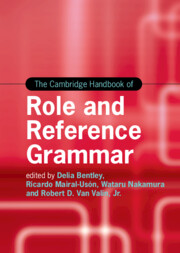Book contents
- The Cambridge Handbook of Role and Reference Grammar
- Cambridge Handbooks in Language and Linguistics
- The Cambridge Handbook of Role and Reference Grammar
- Copyright page
- Dedication
- Contents
- Figures
- Tables
- Contributors
- Pedagogical Guide to The Cambridge Handbook of Role and Reference Grammar
- Introduction
- Part One Overview
- Part Two Topics in RRG: Simple Sentences
- Part Three Topics in RRG: Complex Sentences
- Part Four Applications of RRG
- 17 Role and Reference Grammar and Diachronic Syntax
- 18 Functional Acquisition Processes in Child Language
- 19 Grammatical Aspects of Language Processing in the Brain
- 20 Formalization of RRG Syntax
- 21 Computational Implementation and Applications of Role and Reference Grammar
- Part Five Grammatical Sketches
- Index
- References
19 - Grammatical Aspects of Language Processing in the Brain
A Role and Reference Grammar Perspective
from Part Four - Applications of RRG
Published online by Cambridge University Press: 08 June 2023
- The Cambridge Handbook of Role and Reference Grammar
- Cambridge Handbooks in Language and Linguistics
- The Cambridge Handbook of Role and Reference Grammar
- Copyright page
- Dedication
- Contents
- Figures
- Tables
- Contributors
- Pedagogical Guide to The Cambridge Handbook of Role and Reference Grammar
- Introduction
- Part One Overview
- Part Two Topics in RRG: Simple Sentences
- Part Three Topics in RRG: Complex Sentences
- Part Four Applications of RRG
- 17 Role and Reference Grammar and Diachronic Syntax
- 18 Functional Acquisition Processes in Child Language
- 19 Grammatical Aspects of Language Processing in the Brain
- 20 Formalization of RRG Syntax
- 21 Computational Implementation and Applications of Role and Reference Grammar
- Part Five Grammatical Sketches
- Index
- References
Summary
The past twenty years have brought a revolution in the understanding of how the human brain accomplishes language comprehension, as more sophisticated models have been proposed in response to the discovery of brain regions in the left hemisphere other than Broca’s and Wernicke’s areas involved in syntactic and semantic processing. Nevertheless, some old mysteries remain unsolved. One of these is the surprising finding that some split-brain patients have some linguistic abilities in their isolated right hemisphere, including, for a few, the ability to make grammaticality judgements. If the neural machinery for syntactic processing is found exclusively in the left hemisphere, this should not be possible. This paper proposes an account of this unexpected phenomenon using the grammatical tools of Role and Reference Grammar, and the solution has implications for the theory itself as well as for another old mystery, namely the ability of some aphasics, who cannot correctly interpret reversible passives, to nevertheless judge the grammaticality of sentences.
Information
- Type
- Chapter
- Information
- The Cambridge Handbook of Role and Reference Grammar , pp. 693 - 736Publisher: Cambridge University PressPrint publication year: 2023
References
Accessibility standard: Unknown
Why this information is here
This section outlines the accessibility features of this content - including support for screen readers, full keyboard navigation and high-contrast display options. This may not be relevant for you.Accessibility Information
- 2
- Cited by
